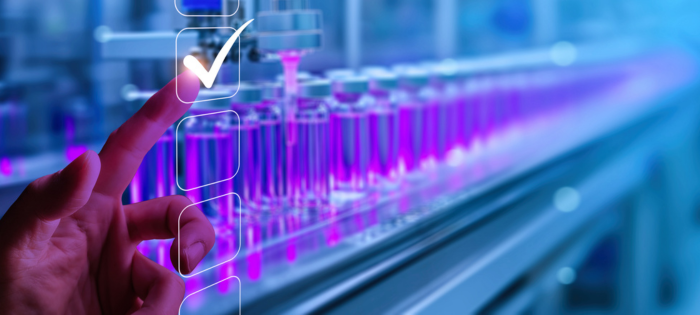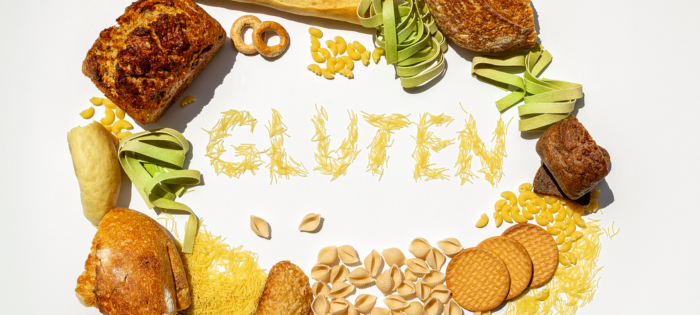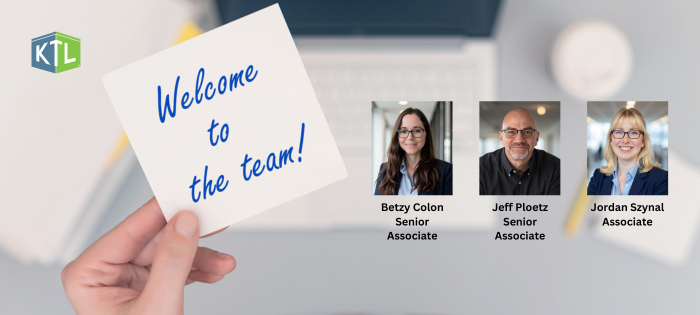
Tech Corner: Chemical Inventory Tool
Functionality: What does it do?
Chemical inventories are required for any organization using or managing hazardous chemicals in the workplace. They can be used to track inventory, communicate hazards, maintain Safety Data Sheets (SDS), and more. For companies using many chemicals, managing chemical quantities, historical usage, and associated documentation can be a challenge. KTL uses the Microsoft Power Platform to build and customize a Chemical Inventory Tool to replace scattered outdated systems, allowing organizations to more efficiently create inventories, track and manage chemicals, and meet regulatory compliance requirements.
Benefits: Why do you need it?
KTL’s Chemical Inventory Tool helps organizations using or managing chemicals to maintain compliance and streamline chemical management processes through:
- Managing Inventory: Maintains an accurate, up-to-date record of all chemicals onsite and their historical quantities.
- Centralizing Data Storage: Stores all chemical information in one location for easy access and consistency across sites.
- Communicating Hazards: Provides employees with quick access to chemical details, associated hazard information, and required personal protective equipment (PPE) for handling the chemical, reducing the risks of chemical handling and storage.
- Maintaining SDS: Connects chemical data to SDSs, helps ensure current versions are available, as required, and can store previous versions to meet the 30-year retention requirement.
- Streamlining Workflows: Creates workflows to manage chemical approvals, provide low supply reminders, and prompt regular chemical and SDS review.
- Reporting: Enables organizations to easily generate chemical inventories to comply with Tier III and Tier II reporting requirements and to provide to Local Emergency Planning Committees (LEPCs) and emergency response personnel.
Technology Used
- SharePoint or Dataverse
- Power Apps
- Power Automate


Comments: No Comments
SQF Edition 10 Delayed
Earlier in 2025, the Safe Quality Food Institute (SQFi) announced it would be releasing Edition 10 of its Safe Quality Food (SQF) Code to align with the latest Global Food Safety Initiative (GFSI) benchmarking criteria, updated regulatory requirements, and scientific changes. The publication date was targeted for September 2025, with audits beginning in April 2026. However, SQFi recently announced that the release of SQF Edition 10 has been delayed due to an extension in the GFSI benchmarking application timeline, which now runs through March 2026.
Because of this delay, SQF Edition 9 will remain the recognized version of the SQF Code. This means that audits will continue under the requirements of Edition 9 until Edition 10 is released. At that point, sites will have a six-month transition period before audits begin under Edition 10.
As KTL reported this summer, the SQF Edition 10 changes remain focus on three critical areas: food safety culture, change management, and environmental monitoring. SQFi has reinforced that, when released, the Edition 10 changes will reflect the industry’s growing understanding that food safety is not just about compliance, but about creating a holistic, proactive approach to protecting consumers.
With the additional time before the release and implementation of Edition 10, now is an ideal time for facilities who are certified to SQF to assess current SQF program elements, identify improvements that are internally desirable and required by Edition 10, and implement those updates that will make the SQF program more useful to the business.

Kestrel Tellevate News / Safety
Comments: No Comments
KTL Safety Culture Article Featured in ASSP’s Professional Safety Journal
An organization’s safety culture is ultimately reflected in the way safety is managed in the workplace. Strong safety cultures have a number of key attributes in common that promote responsible safety and health practices and beliefs across the organization. When these characteristics come together, everyone wins. Benefits that can be expected include:
- Fewer incidents, losses and disruptions
- Improved employee morale
- Increased productivity
- Lower workers’ compensation and insurance claims
- Improved compliance with OSHA regulations and state occupational safety and health programs
- Improved reputation to help attract new or retain existing customers and employees
- Better brand and shareholder value
A safety culture action plan outlines the tools and strategies organizations can use to improve their existing safety culture and ensure that it is integrated with overall business goals, vision, and mission.
Read KTL’s full article, Creating a Safety Culture Action Plan, authored by KTL Senior Associates April Greene, CSP, CHMM, and Will Brokaw, MA, as published in the November 2025 issue of ASSP’s Professional Safety Journal.

Tech Corner Q&A: Using the Software You Have
Having a simple, centralized compliance information management system to manage, track, communicate, and report compliance program information can enable staff to complete required tasks, improve compliance performance, and support operational decision-making. It sounds expensive, but it doesn’t have to be—not when most companies already have the software and just need the right combination of information technology (IT) and quality, food safety, and/or environmental, health, and safety (EHS) expertise to customize it.
We recently sat down with KTL’s Power Platform Team to talk about how organizations can leverage Microsoft 365 and the Power Platform to collect, track, report, and manage compliance; reduce risk; and improve operational efficiency.
Q: First, what is Microsoft 365 and the Power Platform?
Microsoft 365 is a suite of tools built to drive productivity across your organization. If you use Outlook or Office tools like Word, Excel, and SharePoint, then you are already using Microsoft 365. The Power Platform (i.e., Power Apps, Power Automate, Power BI) is an extension of Microsoft 365 that allows users to build and deploy custom business applications, workflows, and dashboards.
Q: Why Microsoft 365 and the Power Platform?
The Microsoft 365 and Power Platform suite of tools can be adapted and designed to manage documents and records, capture data, and provide program reporting to support and meet overall business and compliance needs. The best part? When developing Microsoft 365-based systems, we are not only leveraging software people are already familiar with, but we are also working with existing Microsoft licenses for development. Often, users also have existing licenses that allow them to use the developed systems. This helps keep budgets in check and fosters easy adoption and buy-in.
Q: What does the process look like?
No two projects are exactly alike. The process will vary a bit depending on your company’s current state and needs, but generally, most projects follow three phases:
- Planning: In many cases, companies know exactly what tools they want. In these cases, we meet with team members to get a solid understanding of needs and requirements and then build a scope that meets objectives. Sometimes, the needs aren’t as well defined. In these situations, we start by conducting an assessment to review current information management processes, practices, and tools; help the company set priorities; and develop a development plan that meets identified needs.
- Development, Review, and Rework: We take an iterative and collaborative approach to our development process that emphasizes customer input and feedback. This includes building out tools to a functional point and then requesting feedback to help ensure those tools meet requirements and deliver value.
- Turnover and Continued Support: Once development is complete, turnover is often as simple as setting a date for staff to start using and managing the tools. We conduct training that focuses on the basics of how to use the tools we develop. In addition, we offer continued support to make adjustments that may be needed once you start using the tools.
We help set priorities based on ease of implementation, compliance risk, business improvement, and value to your company. We often recommend starting with something simple—perhaps creating a document library or converting a paper checklist into an electronic form. We can work at your pace and budget to build and integrate only the modules you need one at a time or as a fully functional system. Our goal is to develop the system in a way that will work with your business and encourage buy-in, rather than you having to adapt your business to off-the-shelf software requirements and capabilities.
Q: From a technical standpoint, what will my IT department want to know if we already use Microsoft 365—or if we don’t?
If you already use Microsoft 365, you already have the accounts needed to use most systems KTL builds. Our developers just need access to your tenant to begin building. If you aren’t currently using Microsoft 365 or have not been using SharePoint, KTL will work with your IT department to set up the appropriate infrastructure for the systems we build. This typically involves selecting licensing, establishing a domain, and assigning licenses.
After access is established, our team can begin developing and piloting your system. Once users are comfortable with the applications, we hand the system over to you. The system and information are all yours. All applications run on Microsoft servers, and there are no external or proprietary software requirements. We train your staff to manage the system going forward, so minimal ongoing IT department support is needed.
Q: What are the benefits associated with creating Microsoft 365 system?
Microsoft 365 offers a unified and familiar platform that simplifies access and is adaptable to evolving data management and reporting needs. This allows you to maximize efficiency and connectivity between various operational and corporate groups without the added cost of separate tools. With Microsoft 365 you get:
- Smarter Data and Document Management: Replace paper systems, simplify data entry, and build flexible databases. Upload, organize, and retrieve records with ease.
- Streamlined Communication and Collaboration: Share information, send/receive notifications, and connect teams across departments, sites, and facilities.
- Compliance and Operational Oversight: Manage regulatory tasks, prepare for inspections, and assign role-based permissions to ensure accountability.
- Insightful Reporting and Continuous Improvement: Consolidate reporting, access real-time dashboards, monitor performance, and capture institutional knowledge for long-term sustainability.
Q: What makes KTL’s approach to information management different?
KTL is not a software company. Rather, we adapt Microsoft 365 and the Power Platform to your compliance needs. Our team is made up of EHS, quality, and food safety professionals with the technology expertise to design and build systems that allow you efficiently and effectively manage compliance and business processes. Because we understand regulatory, certification, and operational requirements, we are better able to make sure our technology solutions support your objectives.
Many companies look at software as a silver bullet—a fix for everything. But applying technology to operations isn’t about just finding and buying a software tool. It is about understanding business needs, then adapting and integrating the appropriate tool into existing operations. That means we start with the end user and build around that. If the system doesn’t work for the end user, then it’s not going to be used, no matter how fancy or how many bells and whistles it has.

Comments: No Comments
Gluten Added to Major Allergen Verification
The U.S. Department of Agriculture – Food Safety Inspection Service’s (USDA-FSIS) directive, Ongoing Verification of Product Formulation and Labeling Targeting the Nine Most Common (“Big 9”) Food Allergens, provides instructions to inspection program personnel (IPP) to verify that establishments are controlling and labeling the Big 9 food allergens in meat, poultry, and egg products. On September 11, 2025, USDA-FSIS reissued the directive to include gluten to be verified as an ingredient of public health concern.*
Why Gluten?
Gluten is a protein found naturally in wheat, rye, and barley. Many products contain gluten. According to the USDA, if meat, poultry, or egg products contain any of the following, they likely contain rye or barley and, subsequently, gluten:
- Malt extract
- Malt vinegar
- Rye flour
- Whiskey
- Malt flavoring
- Brewer’s yeast
- Barley flour
- Beer
- Malt syrup
- Yeast extract
- Soups
- Malted milk
- Spent grains
- Brown rice syrup
The National Institute of Health (NIH) estimates there are approximately two million Americans and one percent of the population worldwide who have celiac disease, an auto-immune disease triggered by consuming gluten-containing foods—plus many more with gluten sensitivities and intolerances. As such, the USDA considers gluten an ingredient of public health concern; however, it is not designated a Big 9 major food allergen (though wheat is). Even so, the updated USDA-FSIS directive now requires IPP to verify that establishments are accurately controlling and labeling gluten similarly to the Big 9 allergens.
Formulation Verification
The USDA-FSIS conducted analyses of voluntary recalls connected to undeclared allergens and determined the following:
- Many voluntary recalls occurred due to changes in ingredient suppliers, products in the wrong package or with misprinted labels, or changes to the product or ingredient formulation.
- Establishments failed to include allergens on the product label when product came into contact with an undeclared allergenic ingredient that was not directly added to the product (i.e., unintentional adulteration of product).
When an establishment allows product to enter commerce with undeclared allergens, it signifies that the food safety system has failed in some way to control the hazards associated with the allergens. As such, the purpose of the Big 9 Formulation Verification task is to verify that establishments are properly labeling the Big 9 major food allergens and gluten when included in the formulation of a product to avoid these issues.
During the Big 9 Formulation Verification task, IPP verify the following:
- The establishment has developed and implemented preventive or control measures in its Hazard Analysis and Critical Control Points (HACCP) Plan, Sanitation Standard Operating Procedures (SSOPs), and/or other prerequisite programs (PRPs) to address allergens.
- All ingredients used in the production of the product are present on the product formulation record.
- All ingredients in the product formulation are declared in the ingredient statement on the product label by common name in descending order of predominance.
- All ingredients listed on the labels of incoming food and food ingredients are also listed on the labels of the products in which they are used.
- All ingredients listed in a “may contain” or “produced in a facility” statement on incoming food and food ingredients are also listed on the final product label, except when the establishment contacts the supplier for further clarification and addresses the statement in the hazard analysis.
- The appropriate label is applied to the product.
- The applied label is consistent with the establishment’s label approval on file.
If IPP find that a product contains one of the Big 9 allergens or gluten that is not declared on the final label, they document a food safety labeling noncompliance in a Noncompliance Record (NR).
The Big 9 Formulation Verification task is conducted monthly; however, frequency may increase if there are indicators of an increased risk related to the Big 9 allergens, gluten, ingredients of public health concern, or other undeclared ingredients linked to the establishment, including the following:
- Public Health Alert (PHA) or recall.
- Consumer complaints.
- History of sanitation and/or HACCP NRs.
- History of labeling NRs.
- Recent product formulation changes, adjustments to ingredients, supplier changes, or new products added by the establishment.
Questions to Ask
The USDA-FSIS cautions that these updates do not change the fact that all ingredients, other than processing aids, whether allergens or not, must be declared on the label.
If you produce meat, poultry, and/or egg products, it is important to understand what allergens—and now gluten—you have at your facility, how you use them in product formulation, and how you label them as ingredients in your products. The USDA-FSIS outlines the following questions for the Big 9 Formulation Verification task that you can ask internally to ensure your products comply with labeling requirements:
- Which of the Big 9 allergens and/or gluten are included in products you produce at your facility?
- Does your facility use any components that have multiple ingredients that you do not produce or mix onsite?
- For the selected product, do you have any labels that claim the absence of one or more of the Big 9 allergens and/or gluten?
- For the selected product, do you implement control measures within your HACCP Plan, SSOPs, PRPs, or other programs to prevent misbranding (e.g., mistakes on labeling)?
- For the selected product, do you implement control measures within your HACCP Plan, SSOPs, PRPs, or other programs to prevent allergen cross-contact (e.g., food allergens from one product getting into another product that doesn’t contain the allergen)?
* Note: USDA-FSIS is also removing certain tree nuts that are no longer considered major food allergens from the directive, updating the milk category to include milk from other ruminant animals (e.g., sheep, goats), and updating the eggs category to include eggs from other fowl (e.g., duck, quail), in accordance with the Food and Drug Administration’s (FDA) January 2025 updates to food allergen labeling requirements.

KTL to Present on Human Health Risk Assessments
KTL will be joining the technical program of the Society of Environmental Toxicology and Chemistry (SETAC) North America 46th Annual Meeting November 16-20, 2025 in Portland, Oregon. SETAC is dedicated to advancing environmental science and science-informed decision-making through collaboration, communication, eductaion, and leadership.
KTL Senior Associate Margaret Roy will be presenting Representation of the Homeless in Human Health Risk Assessment on Monday, November 17 at 10:00 am as part of Session 5.08: Beyond Direct Contact: Non-Traditional Exposure Scenarios in Human Health Risk Assessment.
Human Health Risk Assessments (HHRAs) are used to assess contaminant exposure and risk to defined populations, such as residents, commercial workers, and construction workers. HHRAs can also be used to assess risk for the homeless population. This presentation will discuss some of the challenges associated with developing an exposure model to represent the homeless sheltering and living on a contaminated site. For example, interviews with individuals may be necessary to develop an accurate exposure model. The presentation will also discuss the importance of the field sampling crew, from observing field conditions to safety concerns.

Tech Corner: Contractor Safety Management Tool
Functionality: What does it do?
Many organizations rely on external contractors to help deliver products and services. However, using these contractors comes with inherent risks, especially when it comes to safety. Contractor safety management is vital in reducing operational risks, meeting regulatory requirements, and keeping contractors and employees safe. KTL’s Contractor Safety Management Tool supports multiple layers of compliance (e.g., site-level, contractor-level, and employee-level requirements) to help efficiently manage contractor safety requirements—from training, to document management, to proof of qualifications.
Benefits: Why do you need it?
A Contractor Safety Management Tool helps to streamline compliance by keeping all safety-related records in one web-based system, creating the following benefits:
- Maintains proof of qualifications and reduces associated risk by tracking expiration dates and sending reminders before certifications, insurance, or permits lapse (both at the company and individual levels).
- Improves operational safety by providing a centralized location for important safety documents and procedures, such as lockout/tagout (LOTO) procedures and access points.
- Simplifies audits and inspections by organizing safety records in a secure and easily accessible format.
- Efficiently tracks and manages pending, completed, and upcoming training and associated records to help ensure role-specific competency and demonstrate training compliance during audits.
- Increases transparency, enhances accountability, and promotes continual improvement regarding contractor safety performance.
- Maintains a consistent, structured process for completing contractor approvals, including sending notifications.
Technology Used
- SharePoint
- Power Apps (for custom forms)
- Power Automate (for email notifications)


Comments: No Comments
KTL Expands Technical Resources
KTL is pleased to welcome the following new Associates to our team!

Betzy Colon, Senior Associate
Betzy is a senior environmental and social safeguards specialist with nearly 20 years of experience managing multi-sector investment projects, with a focus on project planning, safeguards implementation, strategic monitoring, and regulatory compliance. She has technical expertise in environmental management systems, environmental compliance audits and inspections, human health and ecological risk assessments, site investigations and remediation under CERCLA and RCRA, environmental permitting, and spill prevention and response. Betzy is based in Washington, D.C. Read her full bio…

Jeff Ploetz, Senior Associate
Jeff is an interdisciplinary environmental specialist with over 25 years of experience in environmental, social, and climate risk management. He has a proven track record of strengthening international development programs, environmental regulations, environmental impact assessment procedures, and knowledge management systems. He further has expertise in circular economy; climate mitigation/resiliency; energy efficiency; sustainable development; environmental, social, governance (ESG); strategic planning; and training and technical support.Jeff is based in Arlington, VA. Read his full bio…

Jordan Szynal, Associate
Jordan is an experienced quality and food safety professional with a background working in the chemical manufacturing and construction industries. She is well versed in developing and managing programs, standard operating procedures (SOPs), and work instructions to comply with quality and food safety regulatory compliance and certification requirements. Jordan is based out of the Chicagoland area. Read her full bio…

Comments: No Comments
FSIS Publishes New HACCP Models
The U.S. Department of Agriculture (USDA) published the Pathogen Reduction; Hazard Analysis Critical Control Point (HACCP) Systems Final Rule (9 CFR 417.2(b)(1)) in July 1996, mandating all USDA-inspected meat and poultry establishments implement a system of controls to improve the safety of their products (i.e., a HACCP Plan). To assist in developing these HACCP Plans, the USDA Food Safety and Inspection Service (FSIS) developed a guidebook, accompanied by a generic HACCP model for each food processing category defined in the regulation. Recently, the FSIS published revised models for three different processing categories.
New Models
In June 2025, the FSIS released the two new generic HACCP models for egg products:
- HACCP Model for Pasteurized Liquid Egg Products (Fully Cooked – Not Shelf Stable Category), which includes pasteurized liquid whole egg, pasteurized liquid egg white, pasteurized liquid egg yolk, pasteurized scrambled egg mix products.
- HACCP Model for Dried Egg Products (Heat Treated Shelf Stable Processing Category), which includes spray-dried whole egg, spray-dried egg white, spray-dried egg yolk, spray-dried yolk, and whole egg blends products. This HACCP model illustrates the Heat-Treated Shelf Stable processing category with a dried egg product.
Published in August 2025, the HACCP Model for Ready to Eat (RTE) Fermented, Salt-Cured, and Dried Products (Not Heat Treated – Shelf Stable) applies to products that are cured, dried, or fermented as the sole means to achieve food safety and uses RTE dried fermented sausage as the example product. Products in this category are shelf stable and may be produced as RTE, including:
- Dried sausage, such as salami and pepperoni (if not heat-treated).
- Semi-dry sausages, depending on the process steps.
- Dried whole muscle products that are mostly dry cured, including dried hams (e.g., prosciutto, parma, and country ham) and dried intact pieces of meat (e.g., dried pork bellies (Pancetta), dried pork shoulders (coppa), and dried beef rounds (bresaola, beef prosciutto, and basturma)).
How HACCP Models Help
The generic HACCP models are written to help small and very small federal- and state-inspected establishments (SMEs) that produce meat, poultry and egg products develop their HACCP Plans. In essence, they help to:
- Translate FSIS rules and regulations into plain language and daily operational practices.
- Provide useful examples of how to meet the regulatory requirements.
Each HACCP model represents a food processing category, such as those outlined above. Each processing category may contain numerous products. The models include a product description, ingredients list, production flow diagram, hazard analysis, and HACCP Plan, as well as details regarding regulations and best practices to meet regulatory requirements.
Importantly, generic HACCP models are not intended to be used “as is”. Rather, they serve as examples that establishments must customize to fit the SME’s operations. For example, the model may lend ideas about which critical control points (CCPs) might be effective, offer guidance on the selection of critical limits, or help Food Safety Teams think more creatively about their processes and HACCP system.
While the generic HACCP models cannot guarantee a facility will meet all the regulatory requirements, they are an excellent resource and provide a solid foundation for developing a HACCP system that is focused on producing safe and wholesome products.

KTL Returns to the 2025 Food Safety Consortium
KTL will be joining the 2025 Food Safety Consortium in Arlington, VA, October 19-21, 2025, as a featured panelist and exhibitor. The 14th Annual Food Safety Consortium provides food safety and quality assurance professionals with cutting-edge knowledge, practical skills, and a collaborative network to enhance their professional development as champions of food safety.
KTL will be a panelist on the following breakout session as part of the workshop’s technical agenda:
Beyond the Checklist: Strengthening Supplier Verification for Transparency and Compliance
October 21, 2025 | 9:30-10:30 am | Panelist: Roberto Bellavia, Senior Consultant and Partner
In today’s dynamic regulatory environment, supplier verification is no longer just a documentation exercise—it’s a critical component of a resilient and transparent supply chain. This session will explore how food manufacturers, retailers, and foodservice operators are leveraging digital platforms, risk-based strategies, and FSMA-aligned best practices to ensure supplier compliance and mitigate potential disruptions. Learn how to build verification programs that go beyond minimum requirements to proactively manage risk, foster trust with trading partners, and adapt to evolving traceability expectations. Whether you’re preparing for FDA inspections or looking to streamline supplier onboarding and oversight, this session will equip you with actionable strategies to enhance both transparency and performance across your supply network.
And be sure to stop by and visit us at Booth #21. We look forward to seeing you at the Food Safety Consortium!
